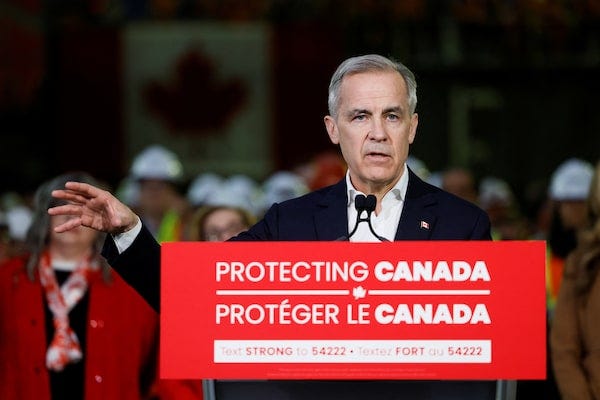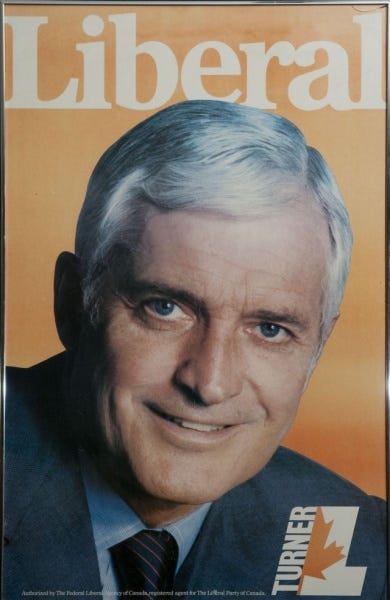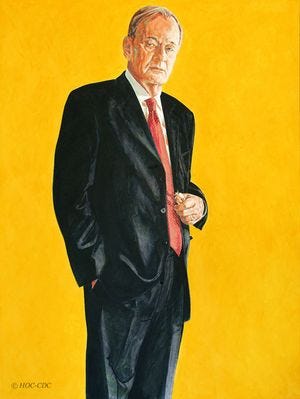The Unexpected Return of Business Liberalism
Regularly pronounced dead, the centrist wing of the party is back, at least temporarily.
In the 1950s, a Canadian political party was closely associated with the largest corporations in the country, promoted closer ties to the United States, and went to the wall for a pipeline. That party of course was the Liberal Party of Canada.
In the late 20th century, the Liberal Party was sometimes said to comprise two wings: “business Liberals” and “welfare Liberals.” You don’t hear the latter term much anymore, it’s now “progressive.” And for a while business Liberalism has mostly been talked about in historic terms; lamenting (or cheering) its death and the party’s dwindling ties with Bay Street and chambers of commerce.
And yet here we are in 2025. The Liberals are led by a former Goldman Sachs banker whose last job was chair of a trillion dollar asset manager that evolved from a branch of the Bronfman family, legendary in late 20th century Canadian business. Under Mark Carney the party has become a tax-cutter: carbon tax gone, capital gains tax raise cancelled, income tax to be cut! In his post Brexit years Mr Carney amused himself with environmental ideas, but he seems over that hobby, and if he has the slightest interest in social policy, progressive ideas, or really anything unrelated to a balance sheet, it’s well-hidden. It’s not even clear if he owns any clothing other than suits.
If Mr Carney pulls this thing off, it will be the second coming of Louis St Laurent, prime minister from 1948 to 1957. A corporate lawyer who only entered politics in 1941 at the age of 59 - same age as Mark Carney, who turned sixty a week after winning the leadership - St. Laurent is mostly a trivia answer these days. He lacked an exciting personality as the last pre-television leader, and his nine years in power are seen as a postwar extension of the long Mackenzie King reign, in which Nothing Much Happened and he acquired the benign name “Uncle Louis.”
There’s an excellent recent book edited by Patrice Dutil, The Unexpected Louis St. Laurent, that shows in fact a lot of interesting stuff did happen, notably the building of the postwar welfare state. Regardless, Louis St Laurent came from the corporate community, was very comfortable with other business elites, and oversaw a government that championed private economic growth.
Now wait, you say. Weren’t the St. Laurent years characterized by the creeping Americanization of the Canadian economy through the proliferation of US branch plants and investment? Didn’t the Liberals blow their political capital in the 1956 pipeline debate by trying to ram an American-dominated project through Parliament? Aren’t we, er, going in a different direction vis-a-vis the Americans today?
Yes we are. But what ties St. Laurent and Carney together, at least based on the latter’s speeches, is their pivotal position in working with the corporate sector to oversee a new economic order. The St. Laurent years were about making Canada a post-British nation, finding logic in reorienting our economic and security ties toward the United States instead. Today, Mr Carney talks about a new economic and security relationship with the United States; it just happens to be in the opposite direction. And in both cases it involves closely working in lockstep with the Canadian corporate community and a decidedly centrist path. Meanwhile his opponent Mr Poilievre went after the CEO of Bell personally last fall, the sort of thing St. Laurent’s onetime opponent John Diefenbaker would do.
Of course, since the St. Laurent years, the secret to Business Liberal success is to avoid being seen as too close to business. John Turner got shellacked in 1984 after nine years hanging around Bay Street, though more for his social and cultural regression than his actual corporate ties. But he made a respectable comeback in 1988 fighting against his old buddies who were embracing the free trade agreement, with words that are now getting resurrected today.
The ultimate Business Liberal in fact was Jean Chrétien, who got along pretty good with corporations but knew he had to occasionally punch them in the face, such as vetoing the big bank mergers of the late 1990s. Paul Martin, who along with Carney and Turner is the only Liberal leader since St. Laurent with any private sector business experience, did not understand this and, along with other reasons, paid the price. It remains to be seen which path Carney, with his Brookfield ties and other baggage, will take.
The post-St. Laurent Liberal prime ministers who were not Business Liberals were Lester Pearson, who made no secret that economic issues were not his thing, and two guys named Trudeau. And indeed, Business Liberals seemed headed for extinction under Justin Trudeau, as they also did under his father, with Bill Morneau’s weak power and eventual defenestration, and Marc Garneau’s non-existent relationship with the PM. (Garneau also illustrates the inaccuracy of the term Business Liberal, since he had no private sector experience yet was a pragmatic centrist, but Centrist Liberal doesn’t have the same ring.) François-Philippe Champagne looked like the lone outrider, and despite his obvious ambition, his prospects for advancement in the party seemed as slim as, well, Mark Carney’s six months ago.
But how things changed. Like the Liberal Party itself, the death of Business Liberalism appears to have again been put on hold. Admittedly, Mark Carney, doing well in the polls at the time of writing but whose political and campaign skills are currently on par with John Turner in 1984, might still be steamrolled and soon be back searching for corporate chairships on LinkedIn. But while there were quite a few things not on my bingo card for 2025, the comeback of Business Liberalism is among the most surprising.







